Hyundai Genesis 2014 Owner's Manual
Manufacturer: HYUNDAI, Model Year: 2014, Model line: Genesis, Model: Hyundai Genesis 2014Pages: 546, PDF Size: 13.59 MB
Page 401 of 546
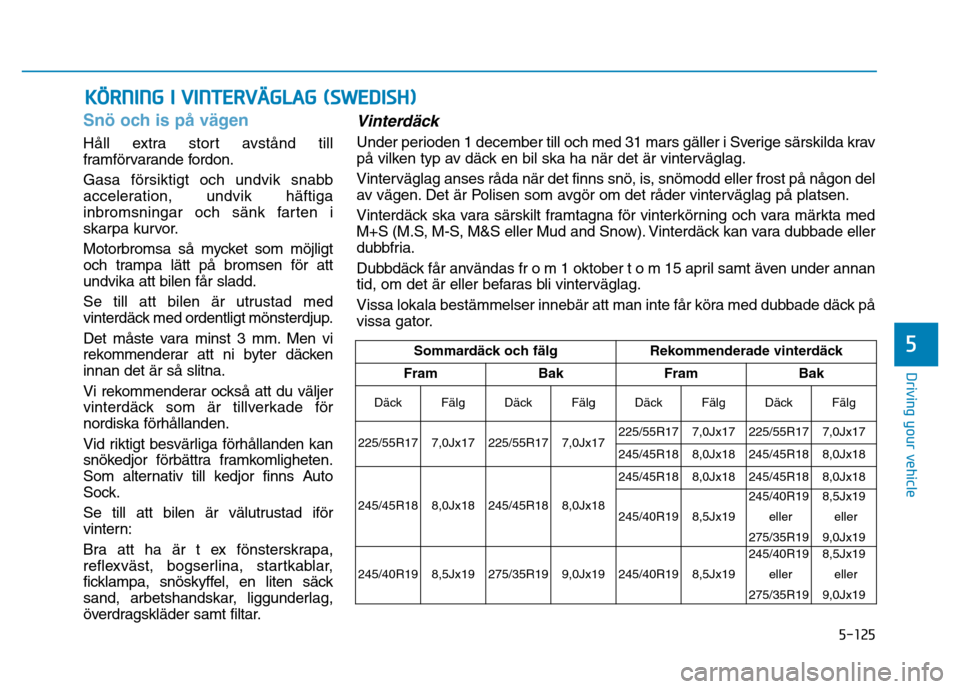
5-125
Driving your vehicle
Snö och is på vägen
Håll extra stort avstånd till
framförvarande fordon.
Gasa försiktigt och undvik snabb
acceleration, undvik häftiga
inbromsningar och sänk farten i
skarpa kurvor.
Motorbromsa så mycket som möjligt
och trampa lätt på bromsen för att
undvika att bilen får sladd.
Se till att bilen är utrustad med
vinterdäck med ordentligt mönsterdjup.
Det måste vara minst 3 mm. Men vi
rekommenderar att ni byter däcken
innan det är så slitna.
Vi rekommenderar också att du väljer
vinterdäck som är tillverkade för
nordiska förhållanden.
Vid riktigt besvärliga förhållanden kan
snökedjor förbättra framkomligheten.
Som alternativ till kedjor finns Auto
Sock.
Se till att bilen är välutrustad iför
vintern:
Bra att ha är t ex fönsterskrapa,
reflexväst, bogserlina, startkablar,
ficklampa, snöskyffel, en liten säck
sand, arbetshandskar, liggunderlag,
överdragskläder samt filtar.
KÖRNING I VINTERVÄGLAG (SWEDISH)
5Sommardäck och fälg Rekommenderade vinterdäck
FramBakFramBak
Däck Fälg Däck Fälg DäckFälg Däck Fälg
225/55R17 7,0Jx17 225/55R17 7,0Jx17 225/55R17
7,0Jx17 225/55R17 7,0Jx17
245/45R18
8,0Jx18 245/45R18 8,0Jx18
245/45R18 8,0Jx18 245/45R18 8,0Jx18 245/45R18
8,0Jx18 245/45R18 8,0Jx18
245/40R19
8,5Jx19245/40R19
eller
275/35R198,5Jx19
eller
9,0Jx19
245/40R19 8,5Jx19 275/35R19 9,0Jx19 245/40R19
8,5Jx19245/40R19
eller
275/35R19 8,5Jx19
eller
9,0Jx19
Vinterdäck
Under perioden 1 december till och med 31 mars gäller i Sverige särskilda krav
på vilken typ av däck en bil ska ha när det är vinterväglag.
Vinterväglag anses råda när det finns snö, is, snömodd eller frost på någon del
av vägen. Det är Polisen som avgör om det råder vinterväglag på platsen.
Vinterdäck ska vara särskilt framtagna för vinterkörning och vara märkta med
M+S (M.S, M-S, M&S eller Mud and Snow). Vinterdäck kan vara dubbade eller
dubbfria.
Dubbdäck får användas fr o m 1 oktober t o m 15 april samt även under annan
tid, om det är eller befaras bli vinterväglag.
Vissa lokala bestämmelser innebär att man inte får köra med dubbade däck på
vissa gator.
Page 402 of 546
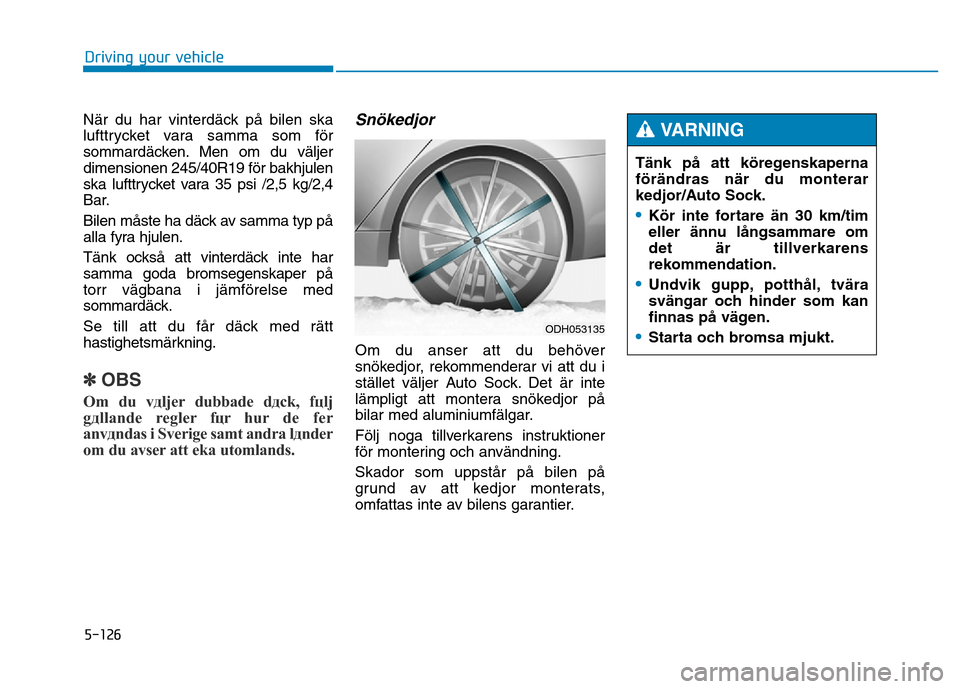
5-126
När du har vinterdäck på bilen ska
lufttrycket vara samma som för
sommardäcken. Men om du väljer
dimensionen 245/40R19 för bakhjulen
ska lufttrycket vara 35 psi /2,5 kg/2,4
Bar.
Bilen måste ha däck av samma typ på
alla fyra hjulen.
Tänk också att vinterdäck inte har
samma goda bromsegenskaper på
torr vägbana i jämförelse med
sommardäck.
Se till att du får däck med rätt
hastighetsmärkning.
✽OBS
Om du vдljer dubbade dдck, fцlj
gдllande regler fцr hur de fеr
anvдndas i Sverige samt andra lдnder
om du avser att еka utomlands.
Snökedjor
Om du anser att du behöver
snökedjor, rekommenderar vi att du i
stället väljer Auto Sock. Det är inte
lämpligt att montera snökedjor på
bilar med aluminiumfälgar.
Följ noga tillverkarens instruktioner
för montering och användning.
Skador som uppstår på bilen på
grund av att kedjor monterats,
omfattas inte av bilens garantier.
Driving your vehicle
Tänk på att köregenskaperna
förändras när du monterar
kedjor/Auto Sock.
•Kör inte fortare än 30 km/tim
eller ännu långsammare om
det är tillverkarens
rekommendation.
•Undvik gupp, potthål, tvära
svängar och hinder som kan
finnas på vägen.
•Starta och bromsa mjukt.
VARNING
ODH053135
Page 403 of 546
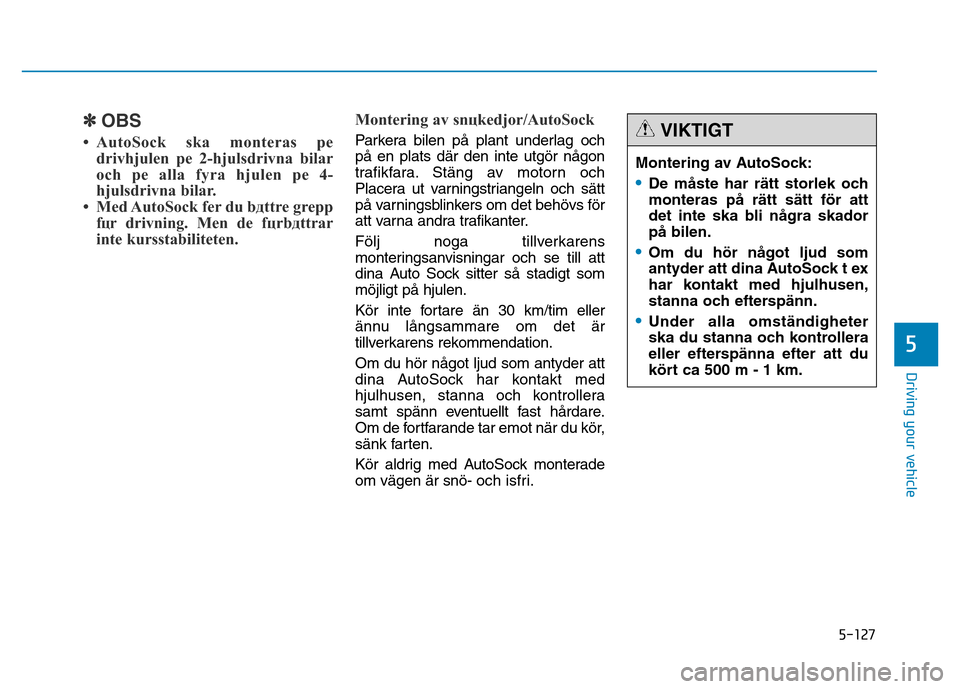
5-127
Driving your vehicle
✽OBS
• AutoSock ska monteras pе
drivhjulen pе 2-hjulsdrivna bilar
och pе alla fyra hjulen pе 4-
hjulsdrivna bilar.
• Med AutoSock fеr du bдttre grepp
fцr drivning. Men de fцrbдttrar
inte kursstabiliteten.Montering av snцkedjor/AutoSockParkera bilen på plant underlag och
på en plats där den inte utgör någon
trafikfara. Stäng av motorn och
Placera ut varningstriangeln och sätt
på varningsblinkers om det behövs för
att varna andra trafikanter.
Följ noga tillverkarens
monteringsanvisningar och se till att
dina Auto Sock sitter så stadigt som
möjligt på hjulen.
Kör inte fortare än 30 km/tim eller
ännu långsammare om det är
tillverkarens rekommendation.
Om du hör något ljud som antyder att
dina AutoSock har kontakt med
hjulhusen, stanna och kontrollera
samt spänn eventuellt fast hårdare.
Om de fortfarande tar emot när du kör,
sänk farten.
Kör aldrig med AutoSock monterade
om vägen är snö- och isfri.
5
Montering av AutoSock:
•De måste har rätt storlek och
monteras på rätt sätt för att
det inte ska bli några skador
på bilen.
•Om du hör något ljud som
antyder att dina AutoSock t ex
har kontakt med hjulhusen,
stanna och efterspänn.
•Under alla omständigheter
ska du stanna och kontrollera
eller efterspänna efter att du
kört ca 500 m - 1 km.
VIKTIGT
Page 404 of 546
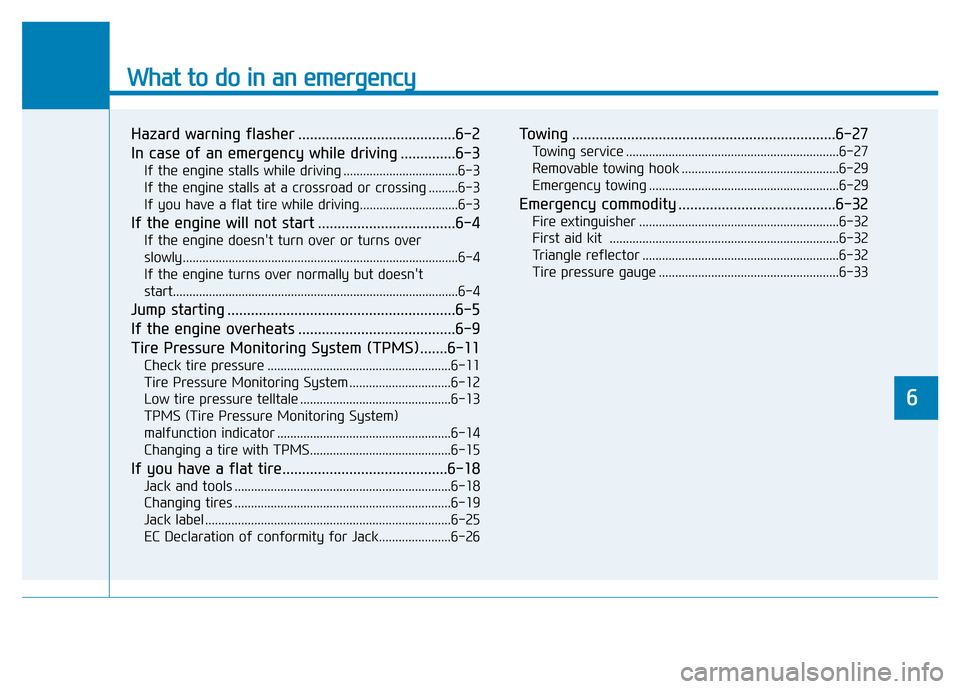
What to do in an emergency
Hazard warning flasher ........................................6-2
In case of an emergency while driving ..............6-3
If the engine stalls while driving ...................................6-3
If the engine stalls at a crossroad or crossing .........6-3
If you have a flat tire while driving..............................6-3
If the engine will not start ...................................6-4
If the engine doesn't turn over or turns over
slowly....................................................................................6-4
If the engine turns over normally but doesn't
start.......................................................................................6-4
Jump starting ..........................................................6-5
If the engine overheats ........................................6-9
Tire Pressure Monitoring System (TPMS).......6-11
Check tire pressure ........................................................6-11
Tire Pressure Monitoring System ...............................6-12
Low tire pressure telltale ..............................................6-13
TPMS (Tire Pressure Monitoring System)
malfunction indicator .....................................................6-14
Changing a tire with TPMS...........................................6-15
If you have a flat tire..........................................6-18
Jack and tools ..................................................................6-18
Changing tires ..................................................................6-19
Jack label ...........................................................................6-25
EC Declaration of conformity for Jack......................6-26
Towing ...................................................................6-27
Towing service .................................................................6-27
Removable towing hook ................................................6-29
Emergency towing ..........................................................6-29
Emergency commodity ........................................6-32
Fire extinguisher .............................................................6-32
First aid kit ......................................................................6-32
Triangle reflector ............................................................6-32
Tire pressure gauge .......................................................6-33
6
Page 405 of 546
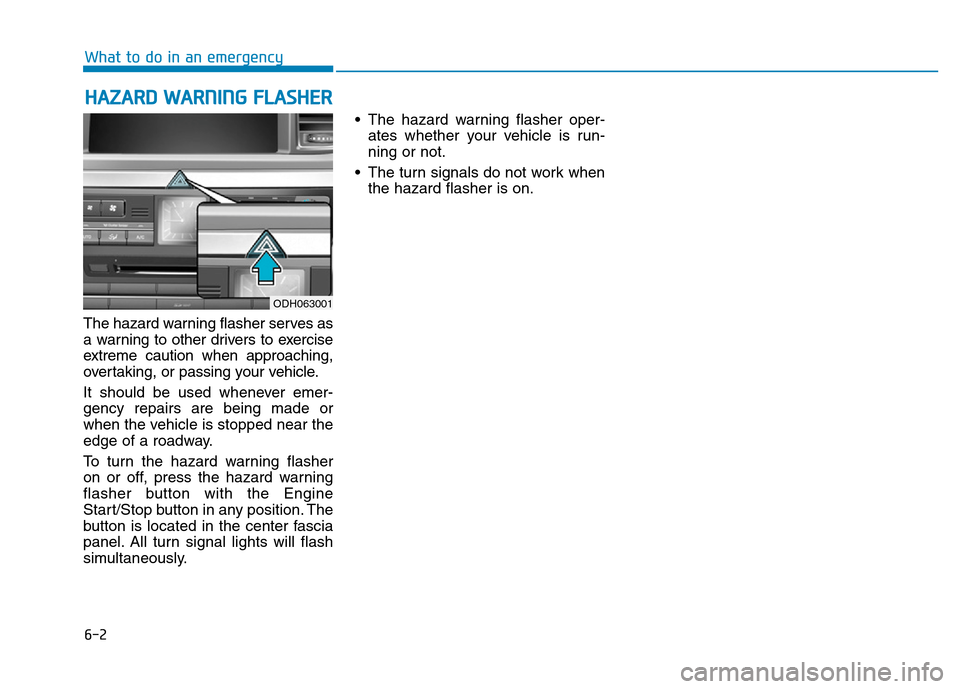
6-2
The hazard warning flasher serves as
a warning to other drivers to exercise
extreme caution when approaching,
overtaking, or passing your vehicle.
It should be used whenever emer-
gency repairs are being made or
when the vehicle is stopped near the
edge of a roadway.
To turn the hazard warning flasher
on or off, press the hazard warning
flasher button with the Engine
Start/Stop button in any position. The
button is located in the center fascia
panel. All turn signal lights will flash
simultaneously.• The hazard warning flasher oper-
ates whether your vehicle is run-
ning or not.
• The turn signals do not work when
the hazard flasher is on.
HAZARD WARNING FLASHER
What to do in an emergency
ODH063001
Page 406 of 546
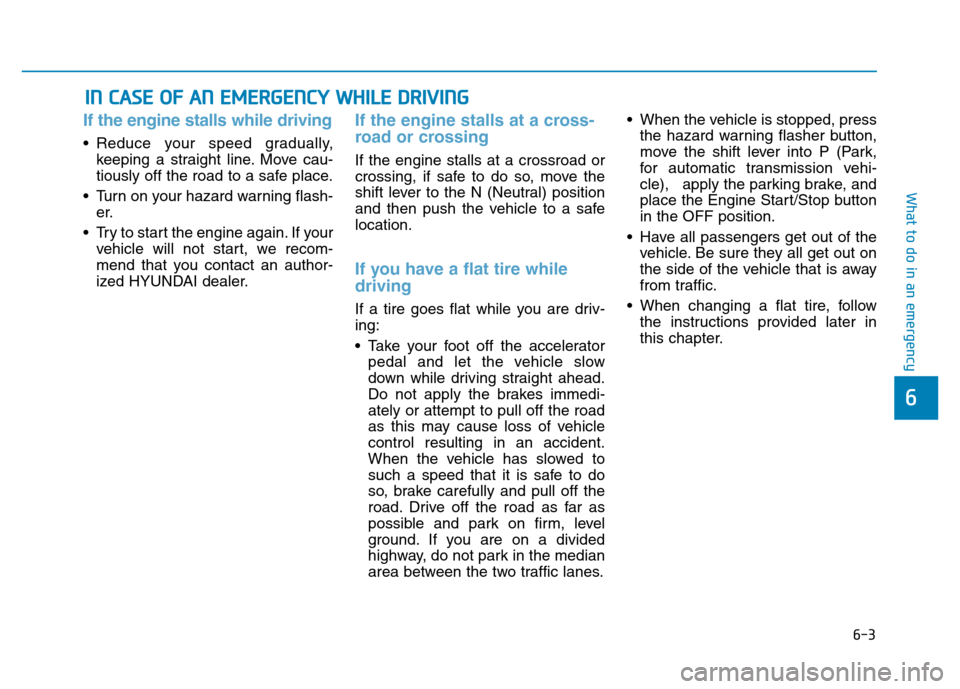
6-3
What to do in an emergency
If the engine stalls while driving
• Reduce your speed gradually,
keeping a straight line. Move cau-
tiously off the road to a safe place.
• Turn on your hazard warning flash-
er.
• Try to start the engine again. If your
vehicle will not start, we recom-
mend that you contact an author-
ized HYUNDAI dealer.
If the engine stalls at a cross-
road or crossing
If the engine stalls at a crossroad or
crossing, if safe to do so, move the
shift lever to the N (Neutral) position
and then push the vehicle to a safe
location.
If you have a flat tire while
driving
If a tire goes flat while you are driv-
ing:
• Take your foot off the accelerator
pedal and let the vehicle slow
down while driving straight ahead.
Do not apply the brakes immedi-
ately or attempt to pull off the road
as this may cause loss of vehicle
control resulting in an accident.
When the vehicle has slowed to
such a speed that it is safe to do
so, brake carefully and pull off the
road. Drive off the road as far as
possible and park on firm, level
ground. If you are on a divided
highway, do not park in the median
area between the two traffic lanes.• When the vehicle is stopped, press
the hazard warning flasher button,
move the shift lever into P (Park,
for automatic transmission vehi-
cle), apply the parking brake, and
place the Engine Start/Stop button
in the OFF position.
• Have all passengers get out of the
vehicle. Be sure they all get out on
the side of the vehicle that is away
from traffic.
• When changing a flat tire, follow
the instructions provided later in
this chapter.
IN CASE OF AN EMERGENCY WHILE DRIVING
6
Page 407 of 546
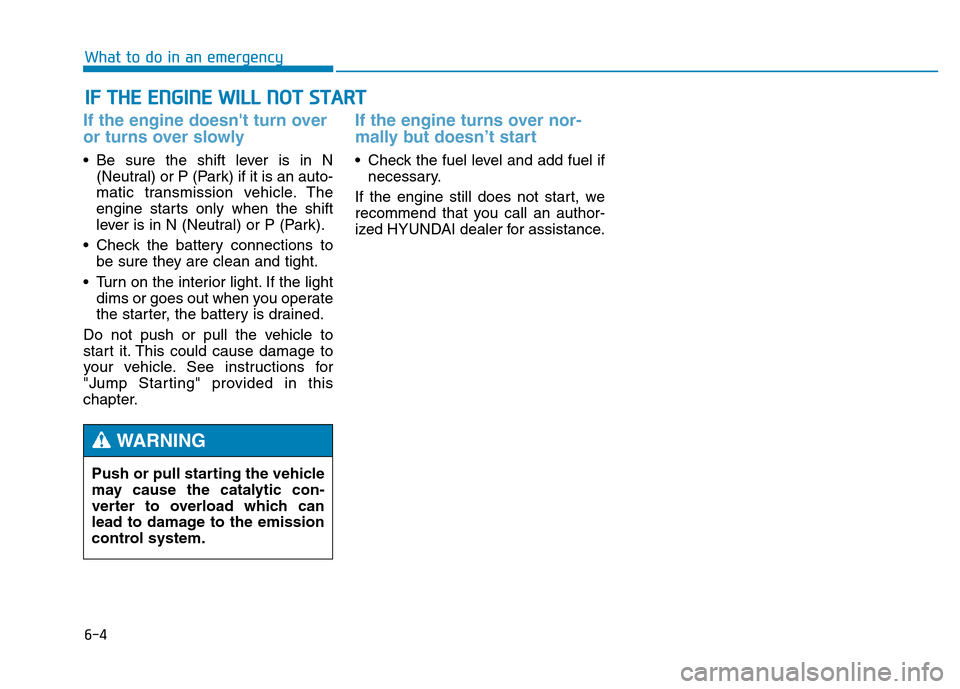
6-4
IF THE ENGINE WILL NOT START
What to do in an emergency
If the engine doesn't turn over
or turns over slowly
• Be sure the shift lever is in N
(Neutral) or P (Park) if it is an auto-
matic transmission vehicle. The
engine starts only when the shift
lever is in N (Neutral) or P (Park).
• Check the battery connections to
be sure they are clean and tight.
• Turn on the interior light. If the light
dims or goes out when you operate
the starter, the battery is drained.
Do not push or pull the vehicle to
start it. This could cause damage to
your vehicle. See instructions for
"Jump Starting" provided in this
chapter.
If the engine turns over nor-
mally but doesn’t start
• Check the fuel level and add fuel if
necessary.
If the engine still does not start, we
recommend that you call an author-
ized HYUNDAI dealer for assistance.
Push or pull starting the vehicle
may cause the catalytic con-
verter to overload which can
lead to damage to the emission
control system.
WARNING
Page 408 of 546
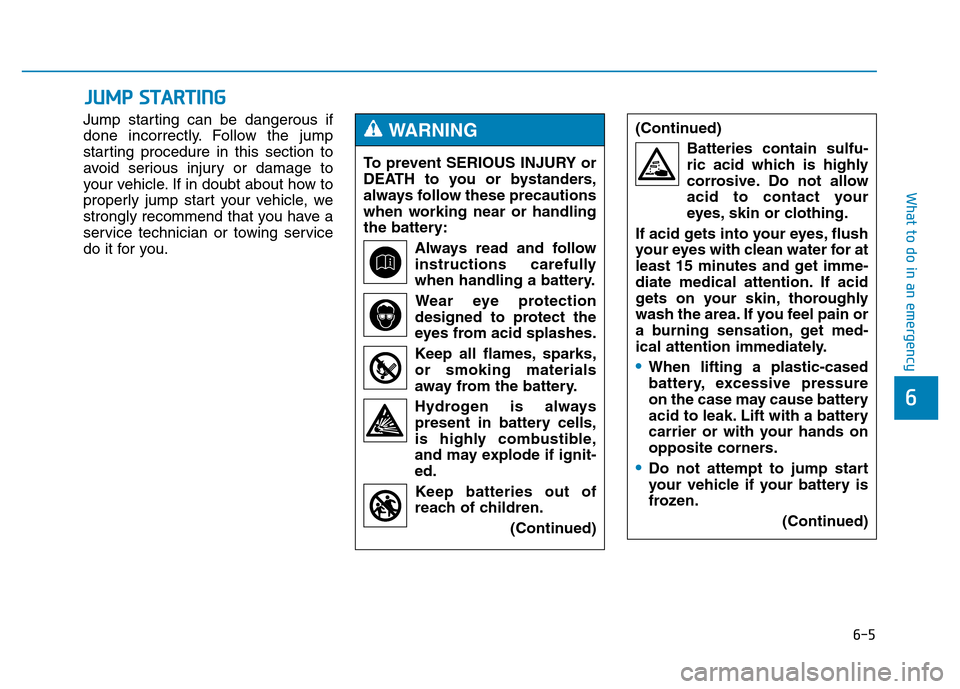
6-5
What to do in an emergency
Jump starting can be dangerous if
done incorrectly. Follow the jump
starting procedure in this section to
avoid serious injury or damage to
your vehicle. If in doubt about how to
properly jump start your vehicle, we
strongly recommend that you have a
service technician or towing service
do it for you.
JUMP STARTING
6
To prevent SERIOUS INJURY or
DEATH to you or bystanders,
always follow these precautions
when working near or handling
the battery:
Always read and follow
instructions carefully
when handling a battery.
Wear eye protection
designed to protect the
eyes from acid splashes.
Keep all flames, sparks,
or smoking materials
away from the battery.
Hydrogen is always
present in battery cells,
is highly combustible,
and may explode if ignit-
ed.
Keep batteries out of
reach of children.
(Continued)
WARNING (Continued)
Batteries contain sulfu-
ric acid which is highly
corrosive. Do not allow
acid to contact your
eyes, skin or clothing.
If acid gets into your eyes, flush
your eyes with clean water for at
least 15 minutes and get imme-
diate medical attention. If acid
gets on your skin, thoroughly
wash the area. If you feel pain or
a burning sensation, get med-
ical attention immediately.
•When lifting a plastic-cased
battery, excessive pressure
on the case may cause battery
acid to leak. Lift with a battery
carrier or with your hands on
opposite corners.
•Do not attempt to jump start
your vehicle if your battery is
frozen.
(Continued)
Page 409 of 546
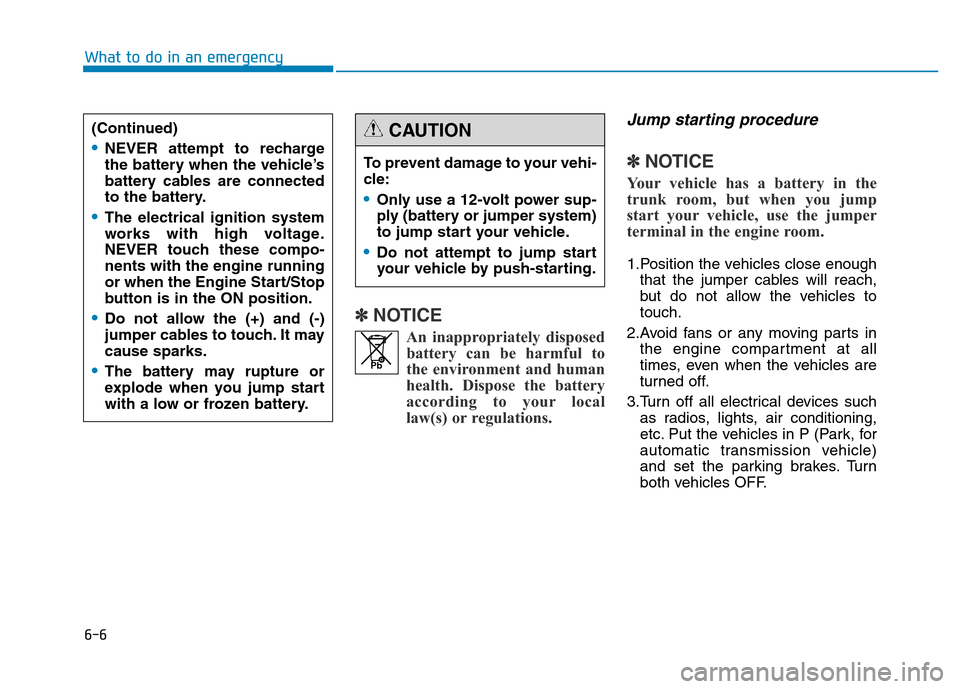
6-6
What to do in an emergency
✽NOTICE
An inappropriately disposed
battery can be harmful to
the environment and human
health. Dispose the battery
according to your local
law(s) or regulations.
Jump starting procedure
✽NOTICE
Your vehicle has a battery in the
trunk room, but when you jump
start your vehicle, use the jumper
terminal in the engine room.
1.Position the vehicles close enough
that the jumper cables will reach,
but do not allow the vehicles to
touch.
2.Avoid fans or any moving parts in
the engine compartment at all
times, even when the vehicles are
turned off.
3.Turn off all electrical devices such
as radios, lights, air conditioning,
etc. Put the vehicles in P (Park, for
automatic transmission vehicle)
and set the parking brakes. Turn
both vehicles OFF.
(Continued)
•NEVER attempt to recharge
the battery when the vehicle’s
battery cables are connected
to the battery.
•The electrical ignition system
works with high voltage.
NEVER touch these compo-
nents with the engine running
or when the Engine Start/Stop
button is in the ON position.
•Do not allow the (+) and (-)
jumper cables to touch. It may
cause sparks.
•The battery may rupture or
explode when you jump start
with a low or frozen battery.
To prevent damage to your vehi-
cle:
•Only use a 12-volt power sup-
ply (battery or jumper system)
to jump start your vehicle.
•Do not attempt to jump start
your vehicle by push-starting.
CAUTION
Pb
Page 410 of 546
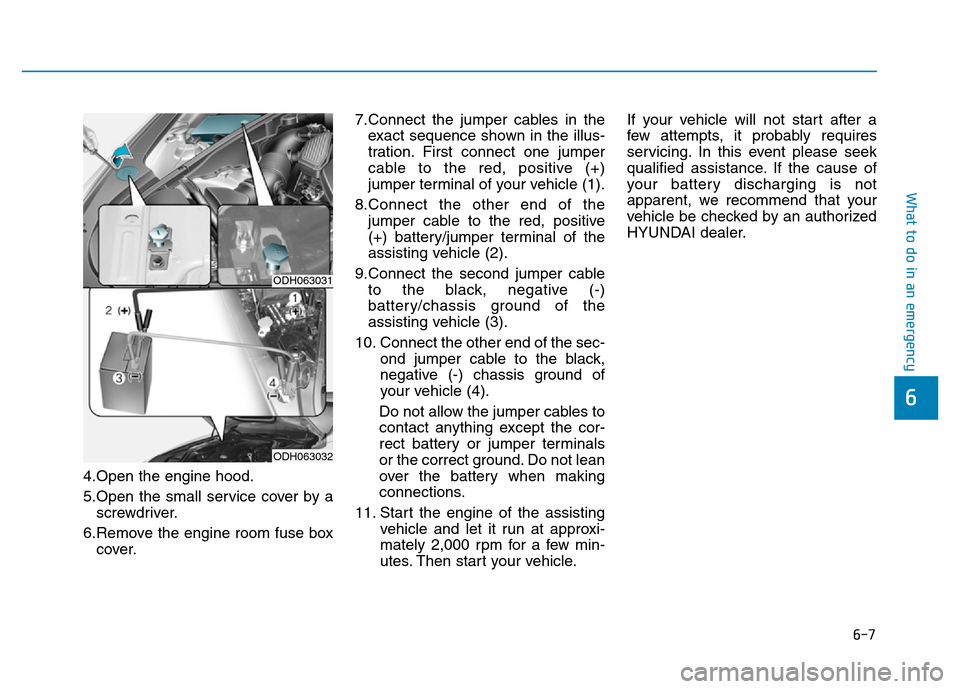
6-7
What to do in an emergency
4.Open the engine hood.
5.Open the small service cover by a
screwdriver.
6.Remove the engine room fuse box
cover.7.Connect the jumper cables in the
exact sequence shown in the illus-
tration. First connect one jumper
cable to the red, positive (+)
jumper terminal of your vehicle (1).
8.Connect the other end of the
jumper cable to the red, positive
(+) battery/jumper terminal of the
assisting vehicle (2).
9.Connect the second jumper cable
to the black, negative (-)
battery/chassis ground of the
assisting vehicle (3).
10. Connect the other end of the sec-
ond jumper cable to the black,
negative (-) chassis ground of
your vehicle (4).
Do not allow the jumper cables to
contact anything except the cor-
rect battery or jumper terminals
or the correct ground. Do not lean
over the battery when making
connections.
11. Start the engine of the assisting
vehicle and let it run at approxi-
mately 2,000 rpm for a few min-
utes. Then start your vehicle.If your vehicle will not start after a
few attempts, it probably requires
servicing. In this event please seek
qualified assistance. If the cause of
your battery discharging is not
apparent, we recommend that your
vehicle be checked by an authorized
HYUNDAI dealer.
6
ODH063031
ODH063032